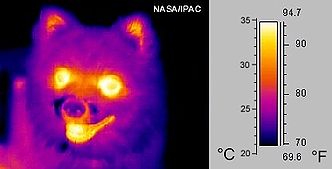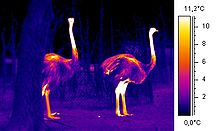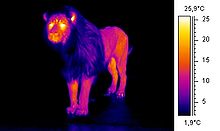Thermography
This article needs additional citations for verification. (July 2008) |





Infrared Thermography, thermal imaging, thermographic imaging, or thermal video, is a type of infrared imaging science. Thermographic cameras detect radiation in the infrared range of the electromagnetic spectrum (roughly 900–14,000 nanometers or 0.9–14 µm) and produce images of that radiation. Since infrared radiation is emitted by all objects based on their temperatures, according to the black body radiation law, thermography makes it possible to "see" one's environment with or without visible illumination. The amount of radiation emitted by an object increases with temperature, therefore thermography allows one to see variations in temperature (hence the name). When viewed by thermographic camera, warm objects stand out well against cooler backgrounds; humans and other warm-blooded animals become easily visible against the environment, day or night. As a result, thermography's extensive use can historically be ascribed to the military and security services.
Thermal imaging has many uses. For example, firefighters use it to see through smoke, find persons, and localize the base of a fire. With thermal imaging, power lines maintenance technicians locate overheating joints and parts, a tell-tale sign of their failure, to eliminate potential hazards. Where thermal insulation becomes faulty, building construction technicians can see thermal signatures that indicate heat leaks and to improve the efficiencies of cooling or heating air-conditioning. Thermal imaging cameras are also installed in some luxury cars to aid the driver, the first being the 2000 Cadillac DeVille. Some physiological activities, particularly responses, in human beings and other warm-blooded animals can also be monitored with thermographic imaging.[1]
The appearance and operation of a modern thermographic camera is often similar to a camcorder. Enabling the user to see in the infrared spectrum is a function so useful that ability to record the output is often optional. A recording module is therefore not always built-in.
The CCD and CMOS sensors used for visible light cameras are not sensitive to infrared light, so most thermal imaging cameras use specialized focal plane arrays (FPAs) that respond to longer wavelengths. The most common types are InSb, InGaAs, HgCdTe and QWIP FPA. The newest technologies are using low-cost and uncooled microbolometers FPA sensors. Their resolution is considerably lower than of optical cameras, mostly 160x120 or 320x240 pixels, up to 640x512 for the most expensive models. Thermographic cameras are much more expensive than their visible-spectrum counterparts, and higher-end models are often export-restricted. Older bolometers or more sensitive models such as InSb require cryogenic cooling, usually by a miniature Stirling cycle refrigerator or liquid nitrogen.
Thermal Energy
It is important to note that thermal imaging displays the amount of infrared energy emitted, transmitted, and reflected by an object. Because of this, it is quite difficult to get an accurate temperature of an object using this method.
Thus, Incident Energy = Emitted Energy + Transmitted Energy + Reflected Energy
where Incident Energy is the energy profile when viewed through a thermal imaging device, Emitted Energy is generally what is intended to be measured, Transmitted Energy is the energy that passes through the subject from a remote thermal source, and Reflected Energy is the amount of energy that reflects off the surface of the object from a remote thermal source.
If the object is radiating at a higher temperature than its surroundings, then power transfer will be taking place and power will be radiating from warm to cold following the principle stated in the Second Law of Thermodynamics. So if there is a cool area in the thermograph, that object will be absorbing the radiation emitted by the warm object. The ability of both objects to emit or absorb this radiation is called emissivity (see below). In outdoor environments, convective cooling from wind may also need to be considered when trying to get an accurate temperature reading.

The thermographic camera would next employ a series of mathematical algorithms. Since the camera is only able to 'see' the electromagnetic radiation that is impossible to see with the human eye, it will build a picture in the viewer and record a visible picture, usually in a JPG format. In order to perform the role of noncontact temperature recorder, it will change the temperature of the object being viewed with its emissivity setting. Other algorithms can be used to affect the measurement, including the transmission ability of the transmitting medium (usually air), temperature of that transmitting medium and others. All these settings will affect the ultimate output for the temperature of the object being viewed.
This makes the thermographic camera an excellent tool for maintenance of electrical and mechanical systems in industry and commerce. By using the camera settings and by being careful when capturing the image, electrical systems can be scanned and problems can be found. Faults with steam traps in steam heating systems are easy to locate.
In the energy savings area, the thermographic camera can do more. Because it can see the radiating temperature of an object as well as what that object is radiating at, the product of the radiation can be calculated using the Stefan–Boltzmann constant.
Emissivity
Emissivity is a term representing a material's ability to emit thermal radiation. Each material has a different emissivity and it can be quite a task to determine the appropriate emissivity for a subject. A material's emissivity can range from 0.00 (completely not-emitting) to 1.00 (completely emitting); the emissivity often varies with temperature.
A Black Body is a theoretical object which will radiate Infrared Radiation at its Contact Temperature. If a thermocouple on a Black Body Radiator reads 50 degrees Celsius, the radiation the Black Body will give up will also be 50 degrees Celsius. Therefore a true Black Body will have an emissivity of 1.
Since there is no such thing as a Black Body, the Infrared Radiation of normal objects will appear to be less than the Contact Temperature. The rate (percentage) of emission of Infrared Radiation will thus be a fraction of the true Contact Temperature. This fraction is called Emissivity.
A table of the Emissivity of many materials and the temperatures that correspond to them are listed in this link.[2] You will note in the table that some objects will have different emissivities in long wave as compared to mid wave emissions. As well emissivites may also change when some materials are at a different temperature.
To make a temperature measurement of an object, the thermographer will refer to the emissivity table to choose the emissivity value of the object which is then entered into the camera. The camera's algorithm will correct the temperature by referring to the emissivity percent and calculate a temperature that would more closely match the actual Contact Temperature of the object.
If possible the thermographer would try to test the emissivity of the object in question. This would be more accurate than attempting to determine the emissivity of the object via a table. The usual method of testing the emissivity is to place a material of known, high emissivity, in contact with the surface of the object. The material of known emissivity can be as complex as industrial emissivity spray which is produced specifically for this purpose or it can be as simple as standard black insulation tape, emissivity 0.97. A temperature reading can then be taken of the object with the emissivity level on the imager set to the value of the test material. This will give an accurate value of the temperature of the object. The temperature can then be read on a part of the object not covered with the test material. If the temperature reading is different, the emissivity level on the imager can be adjusted until the object reads the same temperature. This will give the thermographer a much more accurate emissivity reading. There are times however when an emissivity test is not possible due to dangerous or inaccessible conditions. In these situations the thermographer must rely on tables.
Difference between IR film and thermography
IR film is sensitive to infrared radiation in the 250-500 °C range, while the range of thermography is approximately -50 °C to over 2,000 °C. So for an IR film to show something it must be over 250 °C or be reflecting infrared radiation from something that is at least that hot. Night vision infrared devices image in the non-thermal range of infrared (Near IR) just beyond the visual spectrum, and can see emitted or reflected NIR in complete visual darkness. Starlight-type night vision devices generally only magnify ambient light.
Passive vs active thermography
All objects above the absolute zero temperature will emit infrared radiation. Hence, an excellent way to measure thermal variations is to use an infrared vision device, usually a focal plane array (FPA) infrared camera capable of detecting radiation in the mid (3 to 5 μm) and long (7 to 14 μm) wave infrared bands, denoted as MWIR and LWIR, corresponding to two of the high transmittance infrared windows. Abnormal temperature profiles at the surface of an object are an indication of a potential problem.[3]
In passive thermography, the features of interest are naturally at a higher or lower temperature than the background. Passive thermography has many applications such as surveillance of people on a scene, and medical diagnosis. In active thermography on the other hand, an energy source is required to produce a thermal contrast between the feature of interest and the background. The active approach is necessary in many cases given that the inspected parts are usually in equilibrium with the surroundings.
Advantages of Thermography
- It shows a visual picture so temperatures over a large area can be compared
- It is capable of catching moving targets in real time
- It is able to find deteriorating (i.e. at higher temperature) components prior to their failure
- It can be used to measure or observe in areas inaccessible or hazardous for other methods[citation needed]
- It is a non-destructive test method
- It can be used to find defects in shafts and other metal parts[citation needed]
Limitations and disadvantages of thermography
This section possibly contains original research. (April 2008) |
- Due to the low volume of thermal cameras, quality cameras often have a high price range (often $6,000 USD or above)[citation needed]
- Images can be hard to interpret accurately even with experience[citation needed]
- Accurate temperature measurements are hindered by differing emissivities and reflections from other surfaces [citation needed]
- Most cameras have ±2% accuracy or worse and are not as accurate as contact methods[citation needed]
- Only able to directly detect surface temperatures
Applications
- Condition monitoring
- Medical imaging
- Infrared Mammography
- Veterinary medicine
- Night vision
- Research
- Process control
- Nondestructive testing
- Surveillance in security, law enforcement and defense
- Chemical imaging
- Volcanology
Thermal infrared imagers convert the energy in the infrared wavelength into a visible light video display. All objects above 0 kelvins emit thermal infrared energy so thermal imagers can passively see all objects regardless of ambient light. However, most thermal imagers only see objects warmer than -50 °C.
The spectrum and amount of thermal radiation depend strongly on an object's surface temperature. This makes it possible for a thermal camera to display an object's temperature. However, other factors also influence the radiation, which limits the accuracy of this technique. For example, the radiation depends not only on the temperature of the object, but is also a function of the emissivity of the object. Also, radiation also originates from the surroundings and is reflected in the object, and the radiation from the object and the reflected radiation will also be influenced by the absorption of the atmosphere.
See also
- Chemical Imaging
- Infrared and thermal testing
- X-Reflect glasses
- Infrared camera
- Infrared detector
- Infrared thermometer
- Night vision
- Thermal imaging camera
- Thermographic inspection
- ASTM_Subcommittee_E20.02_on_Radiation_Thermometry
References
- ^ Thermal imaging lights up darkened highways
- ^ http://www.monarchserver.com/TableofEmissivity.pdf
- ^ Maldague X. P. V., Jones T. S., Kaplan H., Marinetti S. and Prystay M. “Chapter 2: Fundamentals of Infrared and Thermal Testing: Part 1. Principles of Infrared and Thermal Testing,” in Nondestructive Handbook, Infrared and Thermal Testing, Volume 3, X. Maldague technical ed., P. O. Moore ed., 3rd edition, Columbus, Ohio, ASNT Press, 2001, 718 p.
External links
- Information on Applications and Usage of Thermal Imaging by Irisys
- Learn more about thermal imaging from Fluke
- Good examples of FLIR thermographic images broken down by industry application
- IrInfo.org, online resource for infrared thermography
- Physical basics
- various examples of thermographic images
- Uncooled Thermal Imaging
- Some uses of thermographic images in medicine
- Some uses of thermographic images in electronics
- Canada Research Chair in Multipolar Infrared Vision – MiViM
- Thermographic images in active volcanoes surveillance system – TIIMNet project Vesuvius and Solfatara INGV Naples Italy
- Thermographic images in active volcanoes surveillance system – TIIMNet project equipment details
- Medical Infrared Imaging - Online resource for medical imaging including images, news, and discussion
- Infrared Medical Solutions - The application of thermography in early stage breast caner risk assessment.
